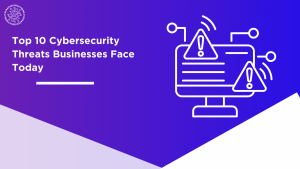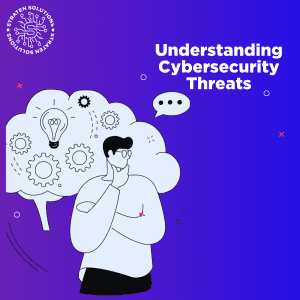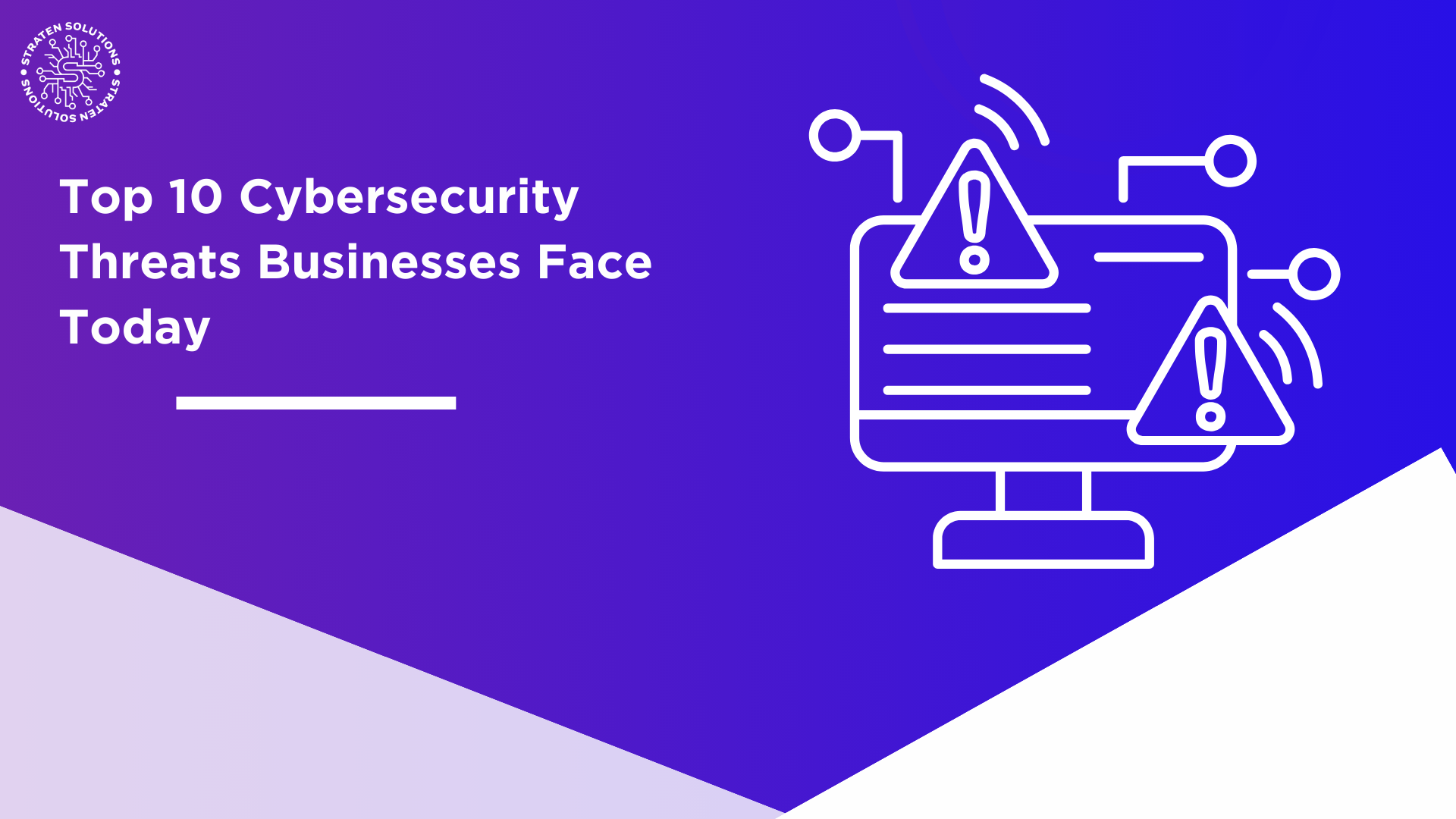
The first step to enhancing your cybersecurity is to gain knowledge about it. Cyber threats are constantly evolving in our digital world, so it’s important always to be vigilant. Just like technology, the tactics used by cybercriminals are becoming more sophisticated, leading to advanced attacks. These cybersecurity threats don’t just pose a risk to data but also to the reputation of a business, its financial stability, and its overall operational sustainability. At Straten Solutions, we understand the challenges companies face in securing their digital assets. Here’s a detailed overview of the top 10 cybersecurity threats you need to be aware of, along with strategies to protect your business against them.
Understanding Cybersecurity Threats

Cybersecurity is a not complex field, understanding the main threats can help you build stronger defenses for cyber threats. Below are the most prevalent cybersecurity threats businesses face today:
1. Phishing Attacks
Phishing attacks involve fraudulent emails or messages that appear to come from legitimate sources. The goal is to trick recipients into revealing sensitive information such as usernames, passwords, or credit card details. For example, an employee receives an email from what appears to be a bank, requesting account verification.
Thinking the email is legitimate, they click on the link and enter their login credentials, which are then stolen by the attacker. Understanding phishing is vital because it is one of the most common and effective methods cybercriminals use, and falling victim to a phishing attack can lead to significant data breaches and financial loss.
2. Ransomware
Ransomware is a type of malicious software that encrypts a victim’s files. The attacker then demands a ransom to restore access to the data. If the ransom is not paid, the attackers threaten to delete the data, which can force the provider to cease operations. Ransomware can cripple business operations, leading to substantial downtime and financial losses. It is crucial to understand how it spreads and how to prevent it.
3. Insider Threats
Insider threats are a common source of cybersecurity issues, yet they are often disregarded. These threats can come from an employee, a compromised account, or even a well-intentioned staff member who unintentionally exposes the organization’s system to hackers. Insider threats involve employees or contractors misusing their access to harm the organization, whether intentionally or accidentally.
Employees, contractors, or business partners with access to sensitive information can pose a risk. Insider threats are particularly dangerous because they can often bypass external security measures.
It’s been reported that 74% of organizations are at least moderately vulnerable to insider threats. In 2022, a significant number of malicious insider attacks and leaks were a result of user negligence.
4. Malware
Malware refers to software designed to infiltrate or damage a system without the owner’s consent. It can corrupt files and spread across a network, causing widespread disruption. Any software engaging in malicious actions, including information stealing or spying, can be classified as malware.
Malware exploits system vulnerabilities. Users may unintentionally install malware when they click on a link in a phishing email, download and install software from an untrustworthy website, plug in an infected USB drive, or visit a website infected with malware.
5. Distributed Denial-of-Service (DDoS) Attacks
A Distributed Denial of Service (DDoS) attack aims to take a website, computer, or online service offline. This is achieved by overwhelming the target with numerous requests, consuming its capacity and rendering it unable to respond to legitimate requests. DDoS attacks can disable a company’s online services by flooding them with excessive traffic.
6. Weak Passwords
Having a weak password poses a significant threat to your business. It is comparable to having a frail lock on a door, offering minimal security against intrusion. In the context of digital security, a weak password is typically easy to guess or crack, providing no real barrier against unauthorized access.
It lacks complexity, length, and unpredictability, making it a prime target for cyberattacks. Weak passwords continue to be a prevalent issue, leaving individuals and organizations vulnerable to various security risks, including data breaches, identity theft, and financial losses.
7. Zero-Day Exploits
A zero-day exploit is a piece of malicious code designed to take advantage of a previously unknown vulnerability in software or hardware. The “zero-day” refers to the fact that software vendors and security professionals have “zero days” to patch the hole because attackers are already using it.
A weakness in a system that no one knows about. The malicious code attackers use to exploit the vulnerability.the actual act of using the exploit to gain unauthorized access to a system.
8. Data breaches
It’s a term we hear often these days, especially in the news with some anonymous corporation involved. But let’s face it – it can seem distant and almost abstract, until it’s not. If a store you shop at experiences a data breach and millions of customer records are at risk, it becomes much more personal. It could be your credit card information, email address, or even your home address. Suddenly, that abstract threat becomes a personal invasion.
Data breaches happen when unauthorized individuals access confidential information. While some cyber criminals use stolen information to harass or extort money from companies and individuals, others sell the breached information in underground web marketplaces that trade in illegal assets.
9. Social Engineering
It’s always important to be wary of unexpected calls from your bank or suspicious links from “friends.” These could be attempts at social engineering, a tactic used by cybercriminals to manipulate people into sharing personal information or compromising security.
Social engineering involves tricking individuals into giving up confidential information or taking actions that are harmful to security. These attacks rely on human psychology rather than technical weaknesses, making them more challenging to identify.
Consider it as a digital age con game. Social engineers take advantage of our natural inclinations, such as trust, kindness, and even fear, to deceive us into doing things we wouldn’t normally do. Stay alert and cautious in your online interactions to protect yourself from falling prey to these tactics.
10. Outdated Software
Outdated software refers to any program that has not been updated to the latest version. Think of a computer program as a fortress, and updates as patches that continuously fix weaknesses in its walls and defenses. Outdated software is like a fortress with crumbling walls, making it easy for attackers to exploit vulnerabilities. Hackers target these weaknesses to gain access to your system and steal your information. Using outdated software may also cause compatibility issues with newer hardware or operating systems, leading to crashes and frustration. Additionally, failing to update software means missing out on new features and improvements, which could potentially hinder your productivity.
How to Prevent Cybersecurity Attacks
As a business owner, safeguarding your company from cybersecurity threats is crucial. Here are some practical steps you can take to enhance your cybersecurity posture and protect your business:
Continuous Employee Training and Awareness
- Organize engaging cybersecurity training sessions to empower your employees to recognize and respond to threats such as phishing and malware.
- Conduct simulated phishing drills to improve employee awareness.
- Encourage continuous learning and staying updated with IT trends and emerging threats through industry resources.
Strong Access Controls
- Implement strict access controls with role-based permissions to restrict access to sensitive data.
- Regularly review access permissions to align with current job responsibilities.
- Utilize multi-factor authentication (MFA) to add an extra layer of security for critical systems and data.
Data Encryption and Reliable Backups
- Encrypt sensitive data in transit and at rest using robust encryption methods.
- Maintain regular backups of critical data in secure offsite locations to mitigate the impact of ransomware and data loss incidents.
- Periodically test data restoration procedures to ensure backup reliability and integrity.
Effective Patch Management
- Establish a proactive patch management strategy to promptly apply security updates across all systems and software.
- Use automated tools for efficient patch deployment to minimize vulnerability exposure in order to enhance your business cybersecurity
- Stay informed about vendor security advisories and conduct thorough research on emerging vulnerabilities and patches.
Comprehensive Incident Response Planning
- Develop a well-defined incident response plan outlining clear procedures for detecting, responding to, and recovering from cybersecurity incidents.
- Identify key personnel and their roles in incident response, including IT security, legal, and communication teams.
- Conduct regular tabletop exercises to simulate cyber incidents and refine response strategies.
By understanding these threats and implementing robust security measures, you can protect your business from potential cyberattacks and ensure the safety of your valuable data. Stay informed and proactive to stay ahead of evolving cybersecurity risks.
How Straten Solutions Can Help
At Straten Solutions, we’ve got your back when it comes to cybersecurity. Our range of services is designed to fit your business like a glove:
- Security Assessments: Let’s get to know your current security setup inside out.
- Managed Security Services: We’ll keep a keen eye on your security infrastructure so you can focus on what you do best.
- Incident Response: If something does happen, we’ve got your back with a rapid response to minimize any impact.
For tailored cybersecurity solutions and more insider tips, click here. We’re here to keep you safe and secure!






